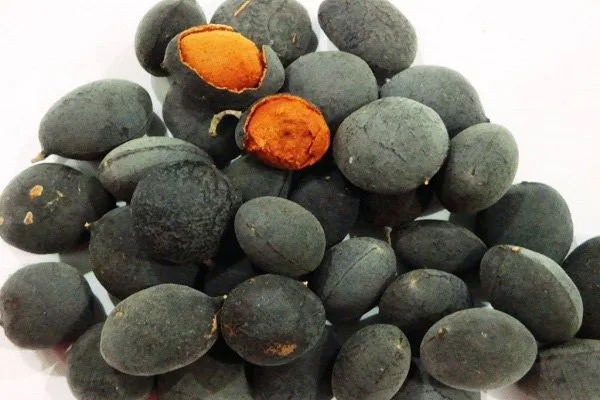Features
Benefits of velvet tamarind
Published
6 days agoon

Velvet tamarind (dialium guineense) commonly known as ‘icheku’ in igbo, ‘awin’ in yoruba and ‘tsamiyar- kurm’ in hausa, and ‘Yooyi’ in Ghana.
-High Antioxidant Power: The fruit is a good source of vitamin C and its consumption can contribute to satisfying the journal requirement that is 90 to 110 mg.
-Treats Scurvy and Infections: The fruit pulp has high ascorbic acid content vitamin hence used as a food supplement. The high vitamin C content boosts the immune system and helps the body against infections.
-Healing Wounds: The velvet fruit pulp has interesting content in calcium and magnesium. Calcium participates in ossification, to the muscular contraction, and to the blood clotting.
-Repairs blood vessel and fights Anemia: The velvet tamarind fruit pulp is rich in iron. It is indispensable for iron absorption; cloves repair and blood vessel formation via collagen synthesis. The pulp’s iron absorption is more efficient because of the presence of vitamin C.
-Prevention of Hypertension: The values obtained for sodium and potassium of the velvet tamarind fruit pulp were respectively Preliminary studies indicate that short-term potassium depletion also elevates bloodpressure in hypertensive patients. Potassium supplementation lowers blood pressure in hypertensive patients ingesting normal amounts of sodium.
-Reliefs Menstrual Cramp and stops Diarrhoea: The stem bark extract has significant analgesic property hence, can be used to reduce menstrual pain. You can take it along with papaya leaf, salt, and water to work effectively. It can also stop diarrhea.
-Hemorrhoids (pile): Piles are swollen veins in the anal canal caused by too much pressure in the pelvic and rectal areas and while not life-threatening, these veins can be very painful. A study performed on ethanolic leaves extract of velvet tamarind showed it to be beneficial for pile treatment.
Source: eprojectlibrary.com
You may like
Fire disasters are gradually becoming an almost normal event in this country. The aftermath of these fire disasters, bring economic hardships to people whose properties have been ravaged, emotional traumas and negative life changing experiences.
There are two main types of fire disasters, those that affect individual homes and those which affect a large group of people like market fires, school dormitories etc. The picture of a man who was weeping uncontrollably after his wife and three children got burnt in a fire disaster which struck his house, will never leave my memory.
The trauma that this individual will experience is so severe that it has the potential to permanently affect his mental health. It is something that any person with an iota of humanity will not wish upon his or her worst enemy.
The Ghana National Fire Service (GNFS) have reported that there were 6436 fire incidents in 2024 which was about 7.7 per cent more than what was recorded in 2023. If this was a GDP percentage growth figure, it would have been good news but this is incidents of fire and therefore very bad news. This year alone, there has been at least two major fire disasters, one at Kantamanto and the recent one at Adum Blue Light area.
TV reports showing wailing women, traders whose livelihood had been destroyed by the devastating fire, was heart wrenching. The question then is, what are the steps or measures being put in place to prevent this incidents from recurring? Given the quality and calibre of personnel in the GNFS, it beats my imagination why such market fires cannot be prevented or if they occur, are not readily dealt with to prevent them getting out of control.
The GNFS conducts investigation into every fire disaster in this country. It can therefore be safely concluded that, they have identified the major causes of these fire outbreaks and there must be measures, to prevent their recurrence. It is therefore unacceptable to see that a fire breaks out and it cannot be contained fast enough, to prevent it from spreading out of control.
The problem in this country is that, we are quick to set up committees to investigate issues but little or nothing is done regarding implementation of the findings or recommendations. A certain attitudinal change is required to ensure a permanent solution for these fire disasters.
If markets are created without proper accesses such that, fire tenders will have easy access to all parts of the markets, not much can be done in the event of a fire outbreak. One of the major issues which according to the PRO of the GNFS, prevented them from quickly attacking the fire, was a lack of access into the market.
One important thing we have to pay attention to is a complaint from the fire men regarding access to hydrant points. The GNFS has reported on several occasions, a lack of access to hydrant points as a result of deliberate building of structures over them. These issues have to be addressed so that fire disasters could be prevented. The fire equipment required by the GNFS must be paid attention to.
The infrastructure that existed some 20 years ago are different from what exists now. Fire tenders with ladders which were adequate for firefighting, are now not fit for purpose because we now have very tall structures in cities like Accra.
The GNFS must be fully and appropriately resourced. Let the powers that be, prioritise fire prevention in this country to prevent painful experiences. God bless.
NB: ‘CHANGE KOTOKA INTERNATIONAL AIRPORT TO KOFI BAAKO INTERNATIONAL AIRPORT’
By Laud-Kissi-Mensah
Social media has revolutionised the way we communicate, interact, and share information. However, beneath its seemingly harmless surface, social media conceals a plethora of significant problems that can have far-reaching consequences on individuals, communities, and society as a whole.
Cyberbullying: The hidden menace
Cyberbullying is one of the most pervasive problems on social media. It involves the use of digital technologies to intimidate, harass, or humiliate individuals, often with devastating consequences.
Cyberbullying can lead to decreased self-esteem, anxiety, depression, and even suicidal thoughts. According to a Pew Research Center survey, 59 per cent of teens have experienced online harassment, while 45per cent have experienced severe forms of harassment, such as physical threats or sustained harassment.
Mental Health Concerns: The unseen toll
Social media can also have a profound impact on mental health. The constant stream of curated and manipulated content can create unrealistic expectations and promote consumerism, materialism, and competition.
This can lead to feelings of inadequacy, low self-esteem, and decreased mental well-being. A study by the Royal Society for Public Health found that social media use is associated with increased feelings of loneliness, anxiety, and depression.
Misinformation and disinformation: The spread of falsehoods
Social media platforms have become breeding grounds for misinformation and disinformation. The ease of sharing information online has created an environment where false or misleading information can spread rapidly, often with serious consequences. According to a study by the Knight Foundation, 70 per cent of Americans believe that misinformation on social media is a major problem.
Addiction: The hidden cost
Social media can be addictive, with many users spending hours scrolling through their feeds, often to the detriment of their mental and physical health.
Social media addiction can lead to decreased productivity, increased screen time, and decreased face-to-face interaction.
A study by the University of California, Irvine found that social media addiction is associated with decreased cognitive performance and increased symptoms of depression.
Online harassment: The unacceptable face
Online harassment is a pervasive problem on social media, with many users experiencing threats, hate speech, and other forms of online abuse. According to a study by the National Center for Victims of Crime, one in five women and one in 10 men experience online harassment.
Privacy concerns: The loss of control
Social media platforms collect vast amounts of personal data, often without users’ knowledge or consent. This can lead to a loss of control over personal information, as well as increased vulnerability to identity theft and cyber-attacks.
According to a study by the Pew Research Center, 72 per cent of Americans believe that social media companies collect too much personal data.
BY ROBERT EKOW GRIMMOND-THOMPSON

Pinkaso is a savory snack made from flour, onions, and pepper.
It is usually paired with Hausa koko (millet porridge) but can be equally enjoyed with any other breakfast cereal or beverage of choice.
Ingredients
-100 grams of all-purpose flour
-1 tablespoonful of salt
-2 grams of dry active yeast
-2 grams of baking soda
-10 grams of chopped onion
-5 grams of fresh pepper
-One bottle of 5 litres oil
Preparation
-Place all the dry ingredients into a bowl and mix and wash under running water
– Blend or grind the onion and pepper
-Add the blended mixture to the flour
-Pour flour in a big bowl and add yeast, salt and baking soda
-Mix into a dough and knead to activate the gluten in the dough
-When the gluten has activated, the dough will look stretchy
– Cover the bowl with cling film and place it in a warm place for the dough to rise
-Deep fry by heating the oil until very hot, then reduce heat to medium
-Fry on medium heat. To take portions of the dough, dip your hands in water, and take a small ball of the dough
-Using your thumb and middle finger, create a hole in the ball of dough and gently drop in the oil and fry on medium heat until golden brown and crunchy
-Remove the pinkaso and place it on kitchen towels to absorb some of the oil. Serve pinkaso with your favourite beverage

Interior minister engages key stakeholders in Ashanti Region

High Commissioner of Babrbados calls on Minister for Tourism

Police arrest two suspects in connection with electrical cables
Trending

 Politics7 months ago
Politics7 months agoVoter Register Discrepancies: NDC to stage nationwide protests against EC

 News8 months ago
News8 months agoArise Royals Montessori School Marks 2nd Graduation.

 Entertainment9 months ago
Entertainment9 months agoGhanaian musician Champions Gaza Peace with New Track

 News4 months ago
News4 months agoKing of Igbo Community in Ghana congratulates Mahama as President-elect of Ghana.

 More8 months ago
More8 months agoYoung people urged to develop their talents

 Entertainment9 months ago
Entertainment9 months agoSteps to receive an official GWR certificate – Details from mother of a Ghanaian record holder

 News9 months ago
News9 months agoCancer Support Network Foundation holds gala

 News9 months ago
News9 months agoDedicate a Portion of GDP for investment in AI to improve health and reduce poverty – Prof. Samuel Kojo Kwofie

















